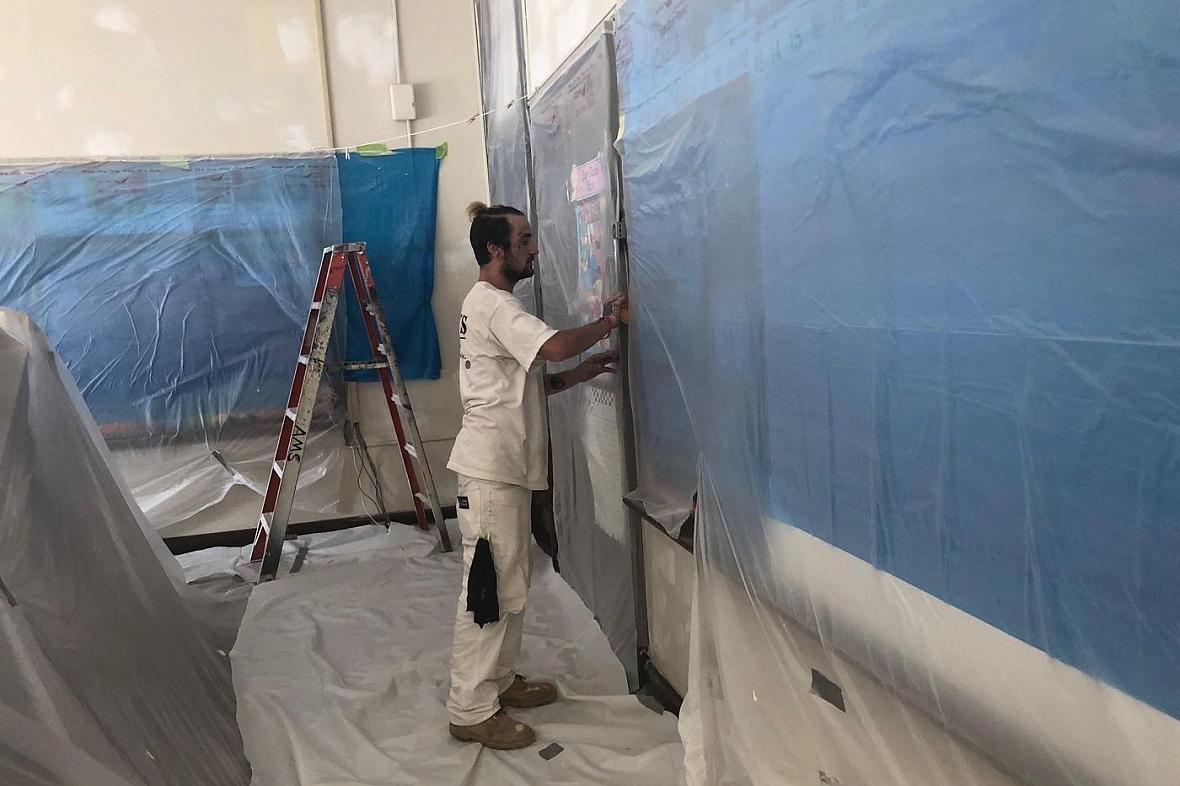Philadelphia school kids will get added protections from lead paint perils
This story was originally published in The Inquirer with support from the USC Annenberg Center for Health Journalism.

A worker performs lead paint and plaster stabilization at Clara Barton Elementary School.
A year after a first grader was severely poisoned from peeling lead paint in his classroom, City Council on Thursday unanimously passed historic legislation aimed at ensuring such an injury never happens again.
Under the legislation, which Mayor Kenney is expected to sign, the School District of Philadelphia must certify its buildings as “safe from lead-based paint hazards” or meet a 90-day deadline to repair damaged paint. Until that happens, the district must clean up hazards daily and restrict student access during repair work.
The measure closes a glaring hole in the city’s safety net to prevent childhood lead poisoning. For the first time, it extends some of the same protections to students who attend public schools that are afforded to children who live in city rental homes.
“As public stakeholders, we agree that building owners, especially those of public facilities, should take all appropriate precautions to mitigate exposure to health risks, including lead paint,” said Danielle Floyd, the district’s chief operating officer, during testimony before a Council committee last week.
Earlier this year, an Inquirer investigation, “Toxic City: Sick Schools,” laid bare the district’s failure to protect students from deteriorating lead paint in rundown elementary schools. Lawmakers said the investigation propelled them to act.
The three-part series documented perils from deteriorating paint and asbestos inside district schools. Reporters enlisted school staffers to take wipe samples for the toxic materials, which then were analyzed by an accredited laboratory. The results found lead contamination in dust on floors and windowsills at multiple times the federal levels set for hazard limits.
“Toxic City" also made public School Checkup, a lookup tool that for the first time gave parents, students, and others records about lead paint hazards and other unsafe conditions inside classrooms.
The investigation also detailed the story of 6-year-old Dean Pagan, who ate lead paint chips that fell onto his desk from his classroom ceiling at Watson Comly Elementary in Northeast Philadelphia. He was hospitalized with a blood-lead level that was nine times that at which doctors worry about permanent damage to the brain.
“It’s sad that it takes a tragedy for big steps to occur,” Cristine Pagan, his mother, said Thursday of the legislation.
The city’s Department of Public Health, which learns of lead poisoning cases through a medical alert system, visited Pagan’s home and found only traces of lead paint, then looked at his school as a possible source of the poisoning.
Typically, when health inspectors found peeling lead paint in the apartment or home of a lead-poisoned child, they didn’t also check the child’s school. The landlord or homeowner must abate the lead-paint hazard or risk fines.
“It is surprising that the health department has not previously had a role in protecting Philadelphia children from lead and other hazards at school,” Marilyn Howarth, a physician and expert in environmental toxicology at the University of Pennsylvania, told Council members during a Dec. 3 hearing on the bill.
For schools that contain lead paint, the inspector, during annual visits, must certify that areas occupied by students are safe from lead hazards, including conditions such as leaky roofs that can cause flaking paint.
The district has 90 days to repair or remediate the damaged lead paint. During repairs, students are not allowed to occupy the area.
In many ways, the legislation adds teeth to the district’s revamped strategy for tackling the lead paint crisis in its schools. Using emergency funding, the district over the spring and summer cleaned up eight elementary schools attended by 3,400 students. The district said it will take 12 to 18 months to complete 38 additional schools that have the most damaged paint.
In all, the district has nearly 200 schools built before the 1978 lead-paint ban. The district estimates it will spend $1 million to hire certified lead inspectors to assess each building.
Lawmakers, district leaders, and members of the Philly Healthy Schools Initiative, a coalition of parents, advocates, environmental scientists, and teachers, worked together to craft the legislation.
Dean Pagan, now 7 and in second grade, attends public school in Ambler and sees a therapist once a week.
“This was the only reason we moved,” his mother said. “Comly was supposed to be one of the better schools in Philadelphia, but it had so much lead that it literally almost killed him.”
Her son still suffers from being poisoned.
“Dean is getting back what he lost academically, but he still has neurological damage,” she said. “He’s impulsive. He can’t sit still. He bounces around. He literally interrupts himself as if someone is cutting him off and talking over him.”


